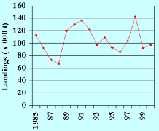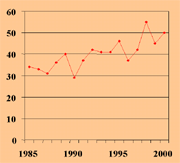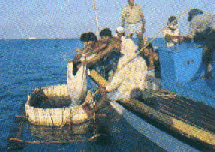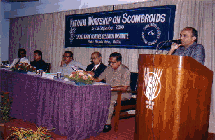|
Pelagic Fisheries Division (PFD)
|
| Technology for Hatchery production of Ornamental fishes | |
| The Division perfected for the first time a technology for hatchery production of the Clownfish Amphiprion chrysogaster. | |
| Trials are on with other ornamental fishes. | |
| Scope for domestic and foreign trade on ornamental fishes. | |
| A marine ornamental fish aquarium at Vizhinjam is also being run successfully. | |
| LESSER SARDINE FISHERY | |||||||||||||||
|
|||||||||||||||
| Bombay Duck (Harpadon nehereus) | |||||||||

|
|
||||||||
| Ribbonfishes (Cutlass, Hairtails) | ||||||||||||||||||||||||||||
|
||||||||||||||||||||||||||||
| Carangids | |

|
Includes the horse mackerel, scads, queenfishes, pompanos and darts, represented by 140 species. Annual production fluctuated between 110,715 t (2000) and 189,737t (1992). It contributes 6% of total marine fish landings in the country. Exploited by trawls, purseseines, ringseine, boastseine, shoreseine, gillnet and hooks and line. Fishery shows high seasonal and regional variations in species composition. |
| Indian Mackerel (Rastrelliger kanagurta) | |||||||||||
|
|||||||||||
| Seerfishes (Kingseer, spottedseer,Wahoo) | |||||||||

|
|
||||||||
| Tunas and Billfishes | |
| Production shows an upward trend. Lowest 37,000 t in 1994 and highest 54,000 t in 2025. Mainly coastal tunas are caught but oceanic tunas not exploited to full potential. Coastal tunas include the little tunny, frigate tuna, bullet tuna, longtail tuna and the oriental bonito. Pole and line fishing done for skipjack and yellowfin in Lakshadweep. | |
| TUNA LIVEBAITS | |||||||||

|
|
||||||||
| WHITEBAITS | |||||||||||
|
|||||||||||
| Division organized a national workshop on SCOMBROIDS | |||||||||||

|
|
||||||||||
| Publications | |
| The Indian oil sardine Sardinella longiceps (Valenciennes) – an annotated bibliography CMFRI Spl. Publication 48 | |
| The Indian Mackerel Rastrelliger kanagurta (Cuvier) – an annotated bibliography CMFRI Spl. Publication 52. | |
| The Ribbon fishes of the family Trichiuridae in India Memoir 1. Marine Biological Association of India. | |
|
| THRUST AREAS IDENTIFIED FOR FUTURE RESEARCH | |
| development of forecast models for multispecies/multigear fishery | |
| correlation of oceanographic and biotic parameters with availability and abundance of major pelagic fish stocks | |
| studies on stock recruitment relationship | |
| survey and assessment of mesopelagic resources in the EEZ and contiguous seas | |
| assessment of techno-economic viability of major oceanic pelagic fishing in Indian EEZ | |
| tagging of oil sardine, mackerel and oceanic tunas | |
| development of hatchery technology for seed production of tuna live-baits and marine ornamental fishes | |
| creating awareness among fishermen and the industry on the conservation and management needs of coastal resources. | |
| Scientist | |||
| S.No | Name | Designation | Area of work |
| 1 | Dr.N.Gopalakrishna Pillai | Principal Scientist & Head of the Division | Pelagic Fisheries |
| 2 | Dr.A.A.Jayaprakash | Principal Scientist | Pelagic Fisheries |
| 3 | Ms.U.Ganga | Scientist | Pelagic Fisheries |
|
|